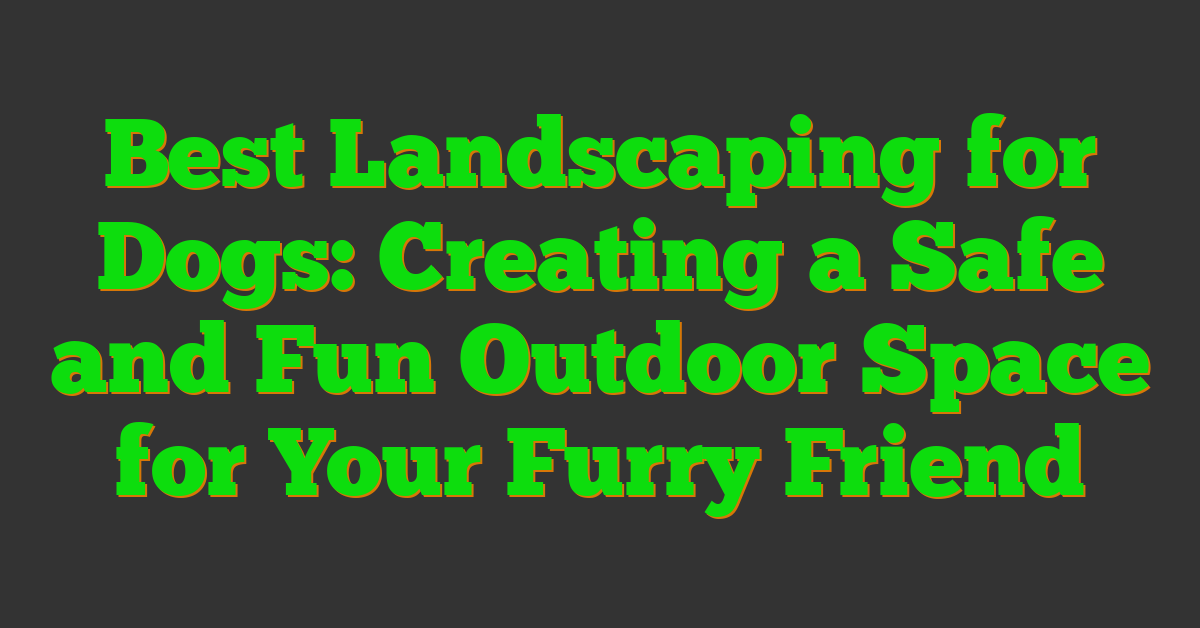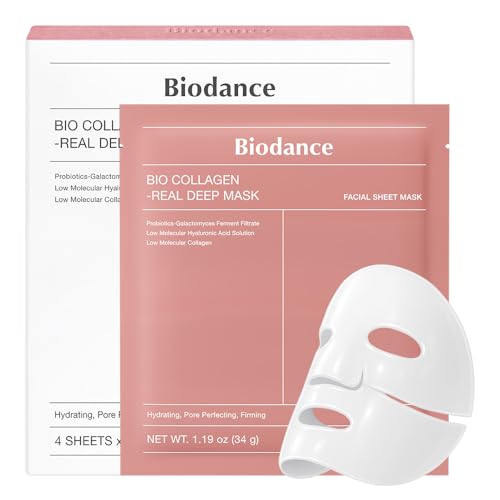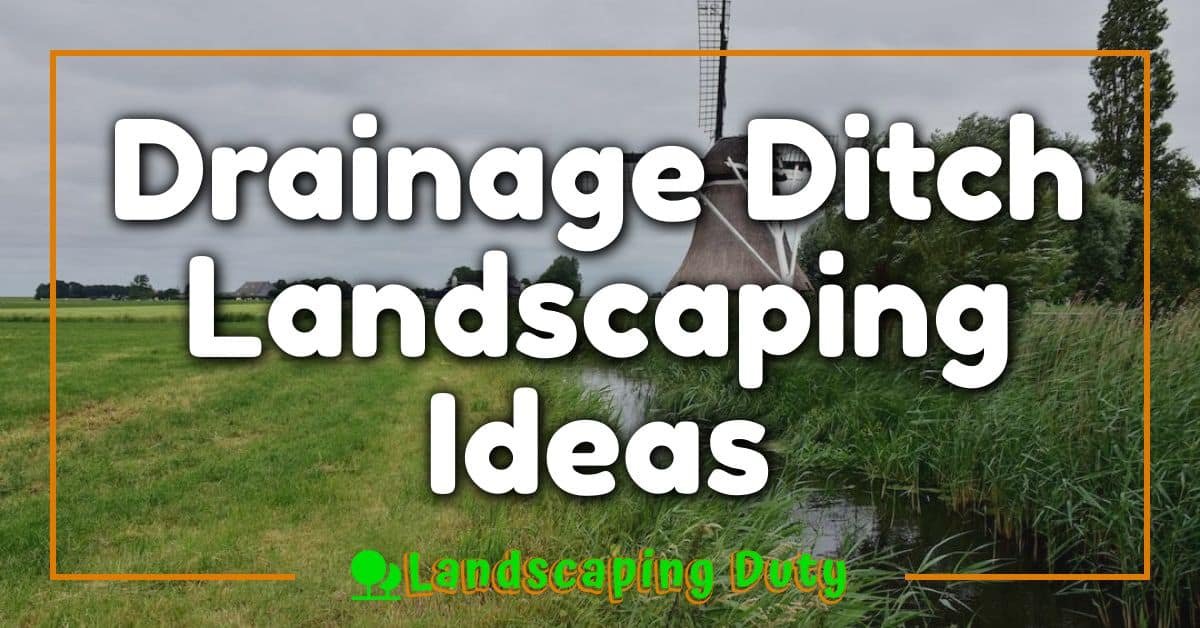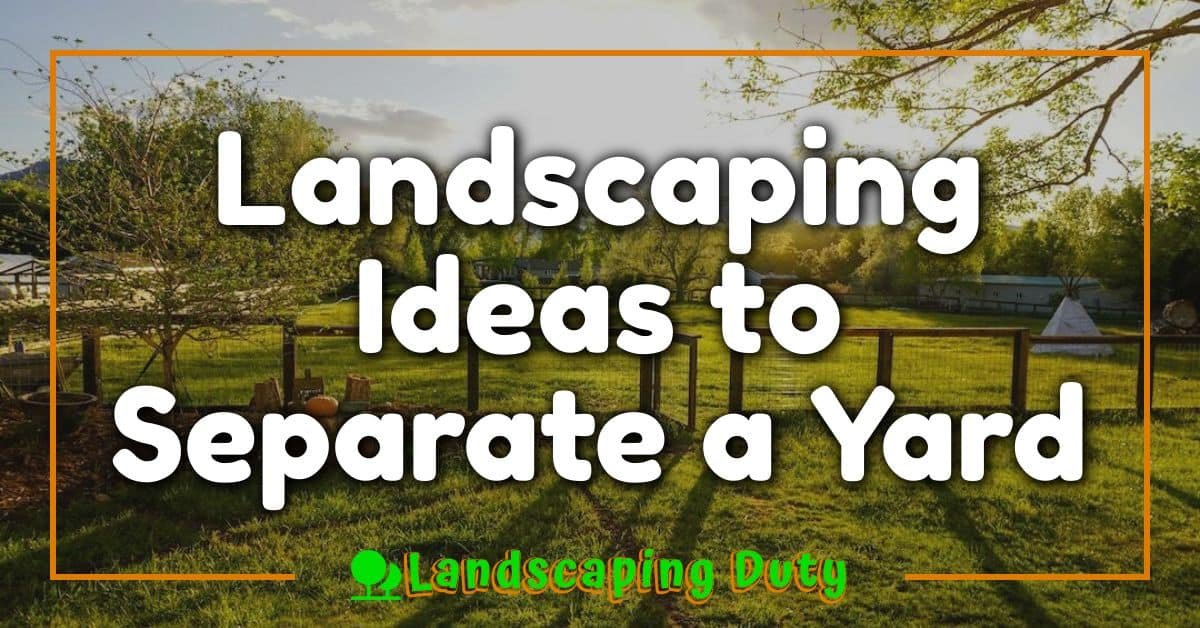If you’re a dog owner, you know how important it is to create a safe and comfortable environment for your furry friend. Landscaping can play a crucial role in providing your dog with a space to run, play, and relax. But with so many options available, it can be overwhelming to decide on the best landscaping for your dog. In this article, we’ll explore some of the key considerations when designing a dog-friendly landscape.

Understanding your dog’s behavior and landscaping needs is the first step to creating a successful dog-friendly landscape. Dogs have specific preferences for things like shade, water, and play areas. You’ll need to take into account your dog’s breed, age, and activity level to create a space that meets their needs. Additionally, you’ll want to consider factors like safety, maintenance, and aesthetics when designing your landscape.
Designing a dog-friendly landscape requires careful planning and consideration. From selecting dog-safe plants and elements to creating functional spaces for your dog, there are many factors to take into account. In the following sections, we’ll explore some of the key elements of a dog-friendly landscape and provide tips and advice for creating a space that both you and your dog will love.
Key Takeaways
- Understanding your dog’s behavior and needs is essential for creating a successful dog-friendly landscape.
- Designing a dog-friendly landscape requires careful planning and consideration of factors like safety, maintenance, and aesthetics.
- From selecting dog-safe plants and elements to creating functional spaces for your dog, there are many elements to consider when designing a dog-friendly landscape.
Understanding Dog Behavior and Landscaping Needs

https://www.youtube.com/watch?v=oWOVKR7sgzM&embed=true
As a dog owner, you know that your furry friend has some natural instincts and activities that can affect your yard. By understanding these instincts, you can create a dog-friendly landscaping that meets your dog’s needs while keeping your yard looking great.
Natural Instincts and Activities
Dogs love to dig, and it’s important to provide them with a space where they can do so without ruining your yard. Consider creating a designated digging area with soft soil or sand. You can also provide your dog with toys and treats to keep them entertained and distracted from digging elsewhere.
Fencing is also an important consideration when landscaping for dogs. Dogs have a natural instinct to roam and explore, so it’s important to make sure your yard is secure. A sturdy fence can help keep your dog safe and prevent them from wandering off.
Safety Considerations in Landscaping
When landscaping for dogs, safety should always be a top priority. Avoid using toxic plants or chemicals that can harm your dog. Instead, opt for dog-friendly plants and natural pest control methods.
If you have a dog that likes to run, consider creating a dog run or enclosed area where they can play safely. This can also help protect your yard from damage caused by excessive running and playing.
By understanding your dog’s natural instincts and activities, you can create a landscaping that meets their needs while keeping your yard looking great. With a little planning and consideration, you can create a safe and enjoyable outdoor space for both you and your furry friend.
Designing a Dog-Friendly Landscape
https://www.youtube.com/watch?v=iLKKWJuDxcc&embed=true
When designing a dog-friendly yard, there are a few important principles to keep in mind. By following these principles, you can create a safe and enjoyable outdoor space for both you and your furry friend.
Landscape Design Principles
Provide ample shade: Dogs need a cool, shaded area to rest when they get too hot. Consider planting trees, installing a pergola, or adding a shade sail to provide shade for your dog.
Create a designated potty area: Dogs need a specific area to do their business. Designate a specific area of your yard for your dog to use as a potty area. Be sure to clean up after your dog regularly to keep the area clean and odor-free.
Incorporate obstacles and features: Dogs love to play and explore. Incorporating features like a small hill, a water feature, or a sandbox can provide endless entertainment for your dog.
Choosing the Right Materials
Choosing the right materials for your dog-friendly landscape is crucial. Here are a few materials to consider:
Mulch: Mulch is a great option for a dog-friendly yard. It provides a soft, comfortable surface for your dog to walk on and helps to keep weeds at bay. Just be sure to choose a non-toxic mulch, such as pine or cedar, to keep your dog safe.
Wood: Wood is a popular choice for dog-friendly landscapes. It can be used to build structures like decks, pergolas, and fences, as well as to create pathways and borders. Just be sure to choose a durable, non-toxic wood like cedar or redwood.
Gravel: Gravel is a great option for a low-maintenance dog-friendly yard. It provides good drainage and is easy to clean up. Just be sure to choose a smooth gravel to prevent injury to your dog’s paws.
Rocks: Rocks are a great way to add texture and interest to your dog-friendly landscape. They can be used to create borders, pathways, and even water features. Just be sure to choose rocks that are smooth and won’t cause injury to your dog.
Hardscape: Hardscape features like concrete, brick, and flagstone are durable and low-maintenance options for a dog-friendly landscape. They can be used to create paths, patios, and even walls and steps. Just be sure to choose materials that are slip-resistant to prevent injury to your dog.
By following these principles and choosing the right materials, you can create a beautiful and functional dog-friendly landscape that both you and your furry friend will love.
Selecting Dog-Safe Plants and Elements
https://www.youtube.com/watch?v=s9tc_6gqGzw&embed=true
When selecting plants and elements for your dog-friendly landscape, it’s important to prioritize safety. Here are some tips to help you choose the best options for your furry friend:
Non-Toxic Plants for Dogs
When it comes to selecting plants for your dog-friendly garden, you’ll want to choose ones that are non-toxic to dogs. Some popular options include:
- Garden herbs like rosemary and lavender, which not only smell great but are also safe for dogs to sniff and nibble on.
- Iris, which is a beautiful and non-toxic flower that can add color and texture to your landscape.
- Non-toxic plants like clover, which can also help to crowd out weeds.
It’s important to note that even non-toxic plants can cause stomach upset if ingested in large amounts. So, it’s always a good idea to monitor your dog’s behavior around plants and seek veterinary care if you suspect they’ve eaten something they shouldn’t have.
Hardscape Features
Another important consideration when designing a dog-friendly landscape is the hardscape features you choose. Here are some options to consider:
- Smooth river rocks or flagstone, which can provide a comfortable surface for your dog to walk on without damaging their paws.
- Raised garden beds, which can help to keep your plants out of reach of curious dogs.
- Dog-friendly mulch, which is made from materials like cedar and can help to keep your garden looking neat and tidy.
By selecting non-toxic plants and dog-friendly hardscape features, you can create a beautiful and safe outdoor space for both you and your furry friend to enjoy.
Creating Functional Spaces for Dogs
https://www.youtube.com/watch?v=4HGcNzte1hg&embed=true
When it comes to designing your backyard for your furry friend, you’ll want to ensure it’s both functional and comfortable. Here are some tips to create the perfect space for your pup.
Play Areas and Dog Paths
Dogs love to run and play, so creating a designated play area for them is a must. Consider installing a sandbox or a digging pit for your dog to play in. This will keep them entertained and prevent them from digging up your garden. Additionally, you can create a dog path that runs along the perimeter of your yard. This will give your dog a safe and comfortable place to walk and explore.
« How Many Landscaping Blocks on a Pallet: A Quick Guide What Kind of Landscapes Can You Find in Pakistan? »
Rest and Shade Areas
Just like humans, dogs need a comfortable place to rest and relax. Consider adding some comfortable seating areas for your dog to lay down and relax. You can also plant some shade trees to provide a cool and comfortable place for your dog to rest during hot summer days. Make sure to choose trees that are non-toxic to dogs, such as maple or dogwood trees.
To sum up, creating a functional and friendly backyard for your dog is all about balance. You want to provide them with plenty of space to play and explore while also giving them a comfortable and safe place to rest and relax. By following these tips, you can create the perfect backyard oasis for your furry friend.
Landscaping Materials and Maintenance
https://www.youtube.com/watch?v=7Ci0btzx-Rs&embed=true
Choosing the Right Mulch
Mulch is a great way to keep your landscaping looking clean and tidy. It also helps to retain moisture and keep the soil cool. However, not all mulches are created equal when it comes to dogs. Some mulches, like cocoa mulch, can be toxic to dogs if ingested. Cedar mulch is a great alternative that is non-toxic to dogs.
When choosing a mulch, it’s important to consider the size of your dog. Small dogs may be more likely to ingest mulch, so it’s best to choose a larger mulch size. Additionally, organic fertilizers can be used to help keep your mulch healthy and looking great.
Lawn Care and Upkeep
Maintaining a healthy lawn is important for both you and your dog. Regular mowing and watering can help keep your lawn looking green and lush. However, it’s important to choose the right type of grass for your dog’s needs.
If your dog spends a lot of time outside, it’s important to choose a grass that can withstand wear and tear. Kentucky bluegrass is a great option for cooler climates, while Bermuda grass is better suited for warmer climates. Additionally, regular fertilization and aeration can help keep your lawn healthy and looking great.
Overall, choosing the right landscaping materials and maintaining them properly can help keep your yard looking great and safe for your furry friend. Remember to always choose non-toxic materials and consider the needs of your dog when making landscaping decisions.
Incorporating Water Features
https://www.youtube.com/watch?v=H-Tdthsz_jM&embed=true
If you have a dog, incorporating water features into your landscaping can be a great way to keep your furry friend entertained and cool during hot summer days. There are two main types of water features that you can add to your landscaping: water sources for hydration and pools and ponds for play.
Water Sources for Hydration
It’s important to make sure your dog has access to fresh water at all times. One way to incorporate water sources into your landscaping is by installing a dog water fountain or a small pond. A dog water fountain is a great option if you have a small yard or if you want to keep your dog’s water separate from your own.
Another option is to create a small pond in your yard. You can use a pre-formed pond liner or create your own pond using a waterproof liner and rocks. Be sure to keep the water clean and free of harmful chemicals.
Pools and Ponds for Play
If your dog loves to swim and play in the water, consider adding a pool or a pond to your landscaping. A pool is a great option if you have a larger yard and want to create a space for your dog to swim and play. You can also add a pool cover to keep the water clean and safe when not in use.
A pond is another great option for dogs who love to swim and play in the water. You can create a natural-looking pond using rocks, plants, and a waterproof liner. Be sure to keep the water clean and free of harmful chemicals.
When incorporating water features into your landscaping, it’s important to keep your dog’s safety in mind. Be sure to supervise your dog at all times when they are near water, and make sure they know how to swim and exit the water safely. With a little planning and creativity, you can create a dog-friendly landscaping that both you and your furry friend will love.
Ensuring a Pet-Friendly Environment
https://www.youtube.com/watch?v=RJJ46oHRJi8&embed=true
As a pet owner, you want to make sure that your furry friend is safe and comfortable in your backyard. Here are some tips to ensure a pet-friendly environment.
Fencing and Boundary Solutions
Fencing is an essential part of a pet-friendly backyard. It keeps your dog safe and secure, preventing them from wandering off and getting lost. A vinyl fence is a great option for pet owners as it is durable and easy to maintain. It is also a good idea to consider invisible fencing as an alternative to traditional fencing. Invisible fencing uses a buried wire to create a boundary that your dog cannot cross. This is a great option if you don’t want to obstruct your view with a physical fence.
Dealing with Pests and Chemicals
Pests and chemicals can be harmful to your dog’s health. Pesticides and flea treatments can be toxic if ingested, so it’s important to keep them out of reach of your pet. Consider using natural pest control methods such as planting mosquito-repelling plants like lavender or citronella. You can also use cedar chips as a natural flea repellent. If you do use pesticides, make sure to read the label carefully and keep your pet away from the treated area until it is safe.
In conclusion, creating a pet-friendly environment in your backyard is all about being mindful of your pet’s needs. By taking the necessary steps to ensure their safety and comfort, you can create a space that both you and your furry friend can enjoy.
Additional Dog-Friendly Landscaping Tips

When it comes to creating a dog-friendly landscape, there are a few additional tips you should keep in mind. In this section, we’ll cover some of the best ways to accessorize your landscape and seasonal considerations to keep in mind.
Accessorizing Your Landscape
One way to make your landscape more enjoyable for your furry friend is to add some accessories. For example, you can add a water feature, such as a fountain or pond, to provide a source of fresh water for your dog. You can also add some dog-friendly plants, such as lavender or chamomile, which can help to relax your dog.
Another great way to accessorize your landscape is to add some containers or raised planter boxes. These can be used to grow dog-friendly plants or to create a designated area for your dog to play or relax in. Plus, they can add some visual interest to your landscape.
Seasonal Considerations
When planning your dog-friendly landscape, it’s important to keep seasonal considerations in mind. For example, in the summer months, you’ll want to make sure your dog has access to plenty of shade and water to stay cool. You can also add some cool surfaces, such as a shallow pool or a shaded deck, to help your dog beat the heat.
In the winter months, you’ll want to make sure your dog has a warm and cozy place to rest. You can add some outdoor heaters or a fire pit to keep your dog warm, or you can create a designated area with some cozy blankets and pillows.
When it comes to dog-friendly landscaping, there are plenty of options to choose from. By following these additional tips, you can create a landscape that is not only beautiful but also functional and friendly for your furry friend.
Frequently Asked Questions
https://www.youtube.com/watch?v=BhHqm6xRoeQ&embed=true
How can I create a drought-tolerant landscape that’s safe for my dogs?
Creating a drought-tolerant landscape that’s safe for your dogs requires careful plant selection and planning. Choose plants that are native to your region and are well-suited to your climate. Plants that are drought-tolerant and require minimal watering are ideal. Consider using hardscaping elements, such as rocks and gravel, to reduce the amount of water needed for your landscape.
What are the best plants to use in a dog-friendly garden?
When selecting plants for a dog-friendly garden, it’s important to choose plants that are safe for your pets. Some plants can be toxic to dogs if ingested, so avoid planting these in your garden. Good options include lavender, rosemary, and marigolds, which are not only safe for dogs but also have natural pest-repelling properties.
What landscaping solutions work well for dogs that like to dig?
If you have a dog that likes to dig, consider creating a designated digging area in your yard. You can fill this area with sand or soft soil to make it more appealing to your dog. Alternatively, you can use hardscaping elements, such as rocks and gravel, to discourage digging in other areas of your yard.
Can you suggest some landscaping ideas for a small backyard with dogs?
If you have a small backyard with dogs, consider creating different zones for different activities. You can create a designated play area for your dogs, as well as a relaxation area for yourself. Vertical gardens and raised garden beds can help maximize your space and provide a beautiful backdrop for your yard.
What ground cover options are safe and comfortable for dogs?
When it comes to ground cover options for dogs, it’s important to choose materials that are safe and comfortable for your pets. Good options include pea gravel, rubber mulch, and artificial turf. These materials are non-toxic and easy to clean, making them ideal for dog-friendly yards.
Is it better to use rocks or mulch in a dog-friendly yard?
Both rocks and mulch can be used in a dog-friendly yard, but each has its own advantages and disadvantages. Rocks are durable and can help prevent digging, but they can also get hot in the sun. Mulch is softer and more comfortable for dogs, but it can attract pests and may need to be replaced more frequently. Ultimately, the choice between rocks and mulch will depend on your specific needs and preferences.










